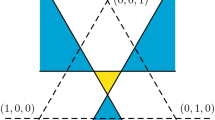Abstract
This paper extends the concept of face games, introduced by González-Díaz and Sánchez-Rodríguez (Games Econ Behav 62:100–105, 2008) for convex games, to the general class of balanced games. Each face of the core is the core of a face game and contains the best stable allocations for a coalition provided that the members of the complement coalition get their miminum worth inside the core. Since face games are exact we investigate several properties of the exact envelope of a balanced game that allow us to characterize exactness, convexity and decomposability of a game in terms of its face games. The close connection between extreme points of the core and extreme points of the face games is analyzed. In particular, we show that the marginal vectors that belong to the core and the lexinal vectors must be marginal vectors and lexinal vectors, respectively, of the single player face games. Finally, we present several subclasses of games where face games could provide some insight on the core structure.

Similar content being viewed by others
Notes
A game such that all of its subgames are exact is called totally exact by Biswas et al. (1999). Obviously if a game is convex then it is totally exact. Conversely, if v is totally exact, then given \(S, T \in 2N\) there exists \(x\in C(v_{| (S\cup T)})\) such that \(x(S\cap T)= v(S\cap T)\) and \(x(S\cup T)=v(S\cup T)\). Then, \(v(S)+v(T)\le x(S)+x(T)=x(S\cup T)+x(S\cap T)=v(S\cup T)+v(S\cap T)\), so v is convex.
This result was initially stated for convex games but, as it is remarked in Shapley (1971), the proof does not use convexity.
References
Biswas AK, Parthasarathy T, Potters JAM, Voorneveld M (1999) Large cores and exactness. Games Econ Behav 28:1–12
Bondareva ON (1963) Some applications of linear programming methods to the theory of cooperative games. Problemy Kibernitiki 10:119–139
Csóka P, Herings PJ, Kóczy L (2011) Balancedness conditions for exact games. Math Methods Oper Res 74:41–52
Estévez-Fernández A, Fiestras-Janeiro MG, Mosquera MA, Sánchez-Rodríguez E (2012) A bankruptcy approach to the core cover. Math Methods Oper Res 76:343–359
Faigle U, Kern W (1992) The shapley value for cooperation games under precedence constraints. Int J Game Theory 21:249–266
Fiestras-Janeiro MG, Sánchez-Rodríguez E, Schuster M (2015) A precedence constraint value revisited. TOP 24:156–179
Gillies DB (1953) Some theorems on \(n\)-person games. PhD thesis, Princeton University
González-Díaz J, Mirás Calvo MA, Quinteiro Sandomingo C, Sánchez Rodríguez E (2016) Airport games: the core and its center. Math Soc Sci 82:105–115
González-Díaz J, Sánchez-Rodríguez E (2008) Cores of convex and strictly convex games. Games Econ Behav 62:100–105
Hamers H, Klijn F, Solymosi T, Tijs S, Pere Villar J (2002) Assigment games satisfy the CoMa-property. Games Econ Behav 38:231–239
Ichiischi T (1981) Super-modularity: applications to convex games and to the greedy algorithm for lp. J Econ Theory 25(2):283–286
Núñez M, Rafels C (1998) On extreme points of the core and reduced games. Ann Oper Res 84:121–133
Núñez M, Rafels C (2003) Characterization of the extreme core allocations of the assignment game. Games Econ Behav 44:311–331
Peleg B (1986) On the reduced game property and its converse. Int J Game Theory 15(120–148):187–200
Shapley LS (1967) On balanced sets and cores. Nav Res Logist Q 14:453–460
Shapley LS (1971) Cores of convex games. Int J Game Theory 1(1):11–26
Tijs S, Borm P, Lohmann E, Quant M (2011) An average lexicographic value for cooperative games. Eur J Oper Res 213:210–220
Acknowledgements
This work has been supported by the European Regional Development Fund (ERDF) and Ministerio de Economía, Industria y Competitividad through Grant MTM2017-87197-C3-2-P and by the Xunta de Galicia through the European Regional Development Fund (Grupos de Referencia Competitiva ED431C-2016-040). We also benefited from Grant ECO2016-75712-P (AEI/FEDER,UE) of Ministerio de Economía, Industria y Competitividad and Grant RGEAF-ECOBAS: ED431B 2019/35 of Xunta de Galicia.
Author information
Authors and Affiliations
Corresponding author
Additional information
Publisher's Note
Springer Nature remains neutral with regard to jurisdictional claims in published maps and institutional affiliations.
Rights and permissions
About this article
Cite this article
Mirás Calvo, M.Á., Quinteiro Sandomingo, C. & Sánchez Rodríguez, E. The boundary of the core of a balanced game: face games. Int J Game Theory 49, 579–599 (2020). https://doi.org/10.1007/s00182-019-00703-2
Accepted:
Published:
Issue Date:
DOI: https://doi.org/10.1007/s00182-019-00703-2



